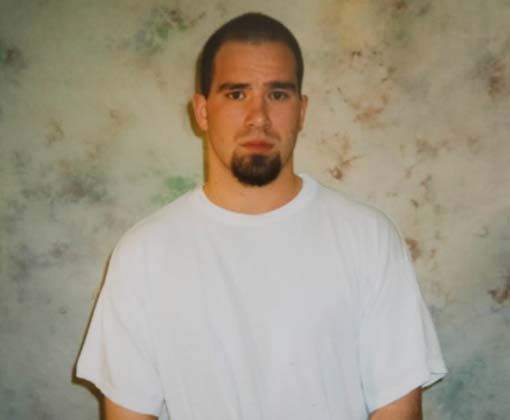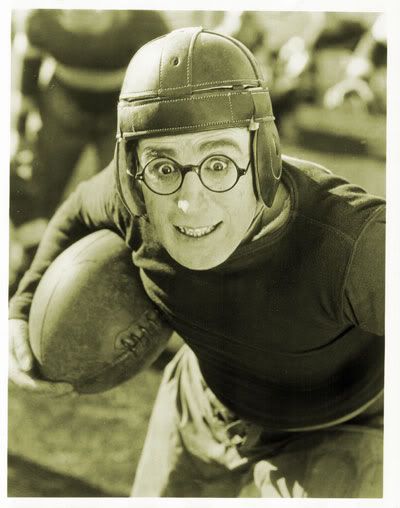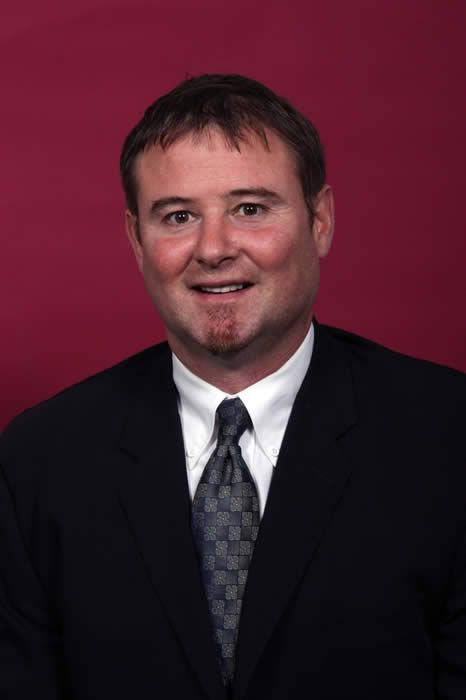 (Cross-posted from cisblog.ca.)
(Cross-posted from cisblog.ca.)Thankfully, the media is not in charge of setting CIS eligibility policy.
There is some told-ya-so with the predictable, kneejerk media uproar over Mike Danton joining the Saint Mary's Huskies. No preening pleased-with-himself pundit was going to pass up taking a run at Danton. Not fulminating over a felon of a former NHLer playing Canadian university hockey, that is like getting a breakaway and dumping the puck into the corner.
Recruiting Danton flew in the face of someone's ideal of CIS hockey, even if that is not supported in actual fact. As Rob said in the comments, if this was a 29-year-old named "Mark Denton," no one would care. That is why CIS should stay the course and ignore the reactionary drive-by media.
Another truth: Danton's age and experience (92 NHL games) are being used as a crutch to cover up the real source of discomfort.
Some of the coverage panders to — perhaps reflects — society's prejudices about ex-cons rejoining society. It also shows the discomfort about confronting how the hockey world was such an enabler for David Frost. People don't want a reminder of what the despicable Frost got away with, so Danton and now SMU are being guilted by association.
That's the only conclusion there is after seeing the major cherry-picks some sportswriters resorted to this week.
The Globe & Mail, which cares so much about CIS it has stopped covering it regularly, has had three articles in the past two weeks pertaining to the average age of university hockey players. Edmonton Journal scribe John McKinnon called Danton a "ringer" and dredged the Jarret Reid saga that occurred more than a decade ago at St. FX. Damien Cox of the Toronto Star apparently couldn't be bothered to ask what the rules are: "Excuse my ignorance, but doesn't 161 games of pro hockey somehow make a player still able to play in the CIS? Could Chris Chelios play for U of T if he so desired?" (Answer: No, and by the way, there was a player in CIS, Jared Aulin, who had 224 NHL and AHL games under his belt when he made a comeback in Canada West.)
McKinnon didn't bother to explain why Saint Mary's should be judged over what happened more than a decade ago at another university in Nova Scotia. What is this, guilt by Grade 3 geography?
No one out of McKinnon and The G&M's reporter James Christie and columnist Roy MacGregor condescended to actually quote a coach of a Top 10 team. They also did not point out something about Saint Mary's coach Trevor Stienburg noted by a Halifax writer, Rick Howe:
"Interesting sidebar story about Trevor Steinburg growing up in Ontario and his father's parole board job. Steven Truscott lived in the Steinburg home for awhile after his parole. Truscott of course was eventually cleared of any involvement in the 1959 death of Lynne Harper."That might have been something to mention as part of the "ethical debate."
The heart of the matter is the media could inveigh against the average age in CIS hockey and of having players with pro experience each year at University Cup time, but they don't. Only now is it suddenly a big deal. Last March, UNB coach Gardiner McDougall's national champion V-Reds last season included 26-year-old Dustin Friesen. Coach Clarke Singer's runner-up Western Mustangs had three 25-year-olds on their roster.
By the way, if this is such a "dirty little secret" in Cox's phrasing, how come it's on the Internet?
Cox or MacGregor could have said something then. They didn't, because it did not involve Danton. As Rob put it:
"Everyone who's crying over how unfair it is, how it's men-vs.-boys ... they really don't care that Danton is older than 'normal'; they care that he was just in prison for trying to have someone killed."To hazard a guess, if asked coaches might have pointed out Danton is a rare case. The current setup works. It's favourable to CIS coaches and is player-friendly, a rarity in amateur hockey.
If coaches have a problem, it probably speaks more to their competitive nature. Basketball coaches did not like it last year when CIS gave former Syracuse guard Josh Wright a year of eligibility back when he joined the Ottawa Gee-Gees. They were worried what it meant for their team, pure and simple. They didn't go off half-cocked about the rules.
Also, if you ask an 18-year-old what his goal is in hockey, and chances the answer will be, "To play as long as I can." Any player that age who could hack it in CIS, which McKinnon calls "clearly a step up from major junior," should have his pick of junior teams.
Come to think of it, committing to play CIS straight from high school instead of waiting a few years could be foolish. It cuts 2-3 years off someone's competitive hockey-playing life. No wonder guys stay in junior and keep their options open. Duh.
Perhaps that is too practical and pragmatic for media types. Their vision seems to be of some puck-chasing 21st-century analogs to Harold Lloyd in The Freshman populating CIS rosters. You wonder if the improved quality of play in the university game makes them nervous, since it makes it harder to justify giving it token coverage.
 Instead, they talk to people who refuse to accept what they knew and loved 20, 30 years ago is gone (what a metaphor for the newspaper industry). For pete's sake, Christie's main source was retired Mount Allison AD Jack Drover.
Instead, they talk to people who refuse to accept what they knew and loved 20, 30 years ago is gone (what a metaphor for the newspaper industry). For pete's sake, Christie's main source was retired Mount Allison AD Jack Drover.Please. Talk about counting on the average reader's unawareness of CIS. Drover is the stodge who presided over the death of men's hockey and basketball as CIS sports at Mount A and the crippling of the football program. He folded the hockey team at Mount A over concerns of "increased professionalism" in AUS, for crying out loud.
" ... the controversial move by St. Mary's (sic) raises the hackles of Drover and others who oppose ex-pros and mature Major Junior A players being allowed to play Canadian university hockey, effectively freezing out recent high-school graduates.Drover did not elaborate on why why this "must" happen outside of his desire to turn the clock back to 1979:
" 'Most students are 18 to 23, and mostly from the regional area where the university is located," said Drover, who coached for 25 seasons and last summer retired as athletic director. 'The rosters of CIS men's hockey teams do not represent this principle. Measures must be taken to resolve this.' "
"There has to be a decision of the athletic directors that the roster has to represent the student profile ... You get more student support if the roster (represents) the student profile instead of recruiting with the buzz phrase 'daycare provided.' "First off, that crack about "daycare provided" is pretty rich. The student-athlete who brought the most media attention to Drover's old school, Mount A, the past couple years, football star Gary Ross, has been rightly celebrated for balancing football and school with being a married father of three. You can't have it both ways, Jack.
The way Christie's article is written also does not make if clear whether one (untenable) solution is actually being considered seriously, or was thrown out off the cuff by a source or the writer.
"One solution would be to ban ex-pros altogether and to deduct one year of university eligibility for each year of major junior hockey played. CIS executive director Marg McGregor indicated the Danton situation will cause hockey coaches to discuss eligibility guidelines at the national championships in March."So, agreeing to weaken teams and accepting a lower calibre of play will increase attendance and student support? Also, a four-year major junior player would get one season of eligibility. Who would even bother to come?
Furthermore, there is zero cause-and-effect between the makeup of a team's roster and student support. If students aren't turning out, it's part the team's record, part poor marketing, part greater demands on students' time and part the revolution taking place with sports consumption. (That link comes from, guess where, The Globe & Mail.)
In the U.S., whether players represent the student profile is a non-factor. Go count how many of those Boise State Broncos are from actually from Idaho.
In Canada, there are dozens of basketball, football, soccer and volleyball teams whose roster fits the quote, unquote student profile. That doesn't spur student support. Winning and convincing people the gym, rink or football stadium is a fun place on a Friday or Saturday drives fan support.
It's better if a team can win with hometown kids, but it's not an end-all. It's a more-power-to-them that Carleton's Dave Smart has built a basketball dynasty with scarcely one player from outside Eastern Ontario.
By Drover's logic, Bruce Langford's Simon Fraser Clan hoops juggernaut isn't playing fair since main cogs such as Kate Hole, Laurelle Weigl and Matteke Hutzler are from Alberta and Ontario. Yeah, that's some real skulduggery, getting ambitious athletes to leave their regional area to play for a powerhouse. What's that called, again? Oh, yeah, coaching!
Meantime, men's hockey coaches work within the unique symbiotic relationship between the CHL and CIS. The CHL gets a bargaining chip in their bid to keep players away from the NCAA. Athletes have a post-junior playing option. University coaches also get the benefit of working with more physically and emotionally mature athletes.
What's not to understand? There is no way of getting the toothpaste back in the tube until such time arrives that there is a total shift in how university athletics is supported in Canada. That is way off on the horizon.
MacGregor says CIS being a destination of choice for Canadian athletes is are "All goals any Canadian will support," but we aren't putting our money where our hearts supposedly are. If that people would be pounding on their elected representatives' doors asking why we aren't funding full athletic scholarships.
Please keep in mind this is coming from a site which would benefit if CIS hockey was as big as the NCAA. Imagine if Taylor Hall, everyone's No. 1 pick in the 2010 NHL draft, was spending his draft year playing for the Windsor Lancers instead the Windsor Spitfires.
Here are the really bad parts of MacGregor:
"(W)hile this is admirable, it has the effect of sending players 20 and older into the university ranks, making it difficult for a 17-year-old freshman to crack a lineup made up of players who have already played major-junior hockey and are already mature men.Seventeen-year-old freshmen (an American term, ironically) seldom crack the lineup anyway since 22-year-old seniors are bigger and stronger. By MacGregor's logic, let's restrict all CIS sports to teens, even though undergrads can easily be 22 or 23 without having done an extra year anywhere.
"In the case of 29-year-old Danton ... this gap between man and child is even more alarming. The notion of a still-growing high school graduate challenging a mature man with three years of NHL hockey to his credit is simply preposterous. No wonder the academically and athletically gifted Canadian high school graduate looks south before looking around home."
Ten minutes of clicking through HockeyDB reveals the truth. The "17-year-old freshman" (MacGregor) and "the kid who graduates high school on time and would like to attend university at the age of 18 and perhaps play for his school" (Cox) does not exist. Did you notice the subtle cheap shot there, implying all CIS players are academic deliquents?
The average age of Saint Mary's team this season is 23.1. The youngest player, second-year forward Andrew White, was born in 1988.
The youngest regular in the eight-team AUS in 2008-09, Dalhousie's Shawn Frank, turned 20 midway through the season (Jan. 6). The youngest player in Canada West, Alberta's J.P. Szaszciewicz, turned 20 five months before the season started. There were a handful of teenagers in the larger OUA. Strange as it sounds, if someone that age could handle the pace of the CIS game, they would be playing junior hockey somewhere.
It would have been nice if MacGregor had faced those facts, or at least done some simple math:
"As for 'professionalism,' the rules are mild — one year of eligibility lost for every year of pro — which still leaves Danton with two years eligibility for university hockey.Actually, if Danton suits up this season, his eligibility runs out in March 2011, when he is 30. That doesn't mean other 31-year-olds can't suit up for CIS teams, but someone that old playing university sports is just such a rarity.
"A 31-year-old varsity player?"
This is getting to be a wordy and belated post, apologies. There was some uncertainly whether it was needed on a niche site such as ours. Ultimately, there had to be a response, since the traditional media blew this out of proportion and painted a false picture of hockey and Canadian Interuniversity Sport. Danton going to SMU isn't really a sports story. It's about how society accepts ex-convicts, which is more of a news story.
 Not everyone would take the chance Steinburg (pictured) and Saint Mary's athletic director Steve Sarty are taking. As a disclaimer, this is more of press criticism than an endorsement.
Not everyone would take the chance Steinburg (pictured) and Saint Mary's athletic director Steve Sarty are taking. As a disclaimer, this is more of press criticism than an endorsement.Saint Mary's has staked a lot on Danton. There probably will have to be some boundaries for dealing with the media. Stienburg will have to put boundaries on how Danton, a former NHL agitator who was good for a 100-plus penalty minutes a season, conducts himself on the ice.
You do not have to be onside with this, let alone nominate them for sainthood. However, it would be great if the media worked to get past their prejudices, its guilt about the Frost saga, and tried some clear thinking. They could have at least made a token effort to understand the new reality of CIS hockey. Instead, they ended up doing a lot of talking and zero listening. Shame on them.
Related:
Former university coach assails Danton ruling; CIS team rosters, currently without age limitations, should better reflect the student profile, Drover argues (James Christie, The Globe & Mail)
Using Danton as a ringer is disgraceful (John MacKinnon, Canwest News Service)
CIS needs to use common sense about allowing 29-year-old former pro to play (Roy MacGregor, The Globe & Mail)






6 comments:
As usual Neate, you go right to the meat of the matter. What will ultimately count is what Danton will contribute to the team, not his background !
Harold
Right on - the only take on this with some kind of legitimate background knowledge. Thanks for encapsulating my outrage at all these idiotic newspaper columnists who evidently put precious little effort into their analysis. And they wonder why it's a dying medium.
Personally, I think it's great that CIS hockey can help attract people to universities, who otherwise might not have even considered a post-secondary education. While older CIS players probably won't go on to crack a professional roster, they will (hopefully) graduate with some kind of degree, and be in a better position to contribute to society in a meaningful way. Or, at least they will have some really neat stuff to tell us about geology and pop music...
While I am not sure I'm happy with Danton playing hockey in the CIS, I am glad he is taking an opportunity to get an education. After his many years in the David Frost "cult" he is getting a second chance and if he takes it seriously he will get a better chance to have a real life. I wish him the best of luck in school.
Totally disagree. I'm happy that Mike Danton is apparently trying to get his life back together, but an NHL VET has no business playing any type of college hockey. As a US fan, perhaps this is my bias showing. I often don't agree w/ the NCAA, but on this I think they have it right. And I couldn't care less how old he is.
On a general point, I would tend to agree ... and it probably does little good for me to point out to an American that we have our own rules that work well for us Canada (for instance, 5 years' eligibility instead of 4).
The point was for that people in Canada have had years to complain about ex-pros in university hockey. Former L.A. King Jared Aulin (now back in the AHL) suited up for the Calgary Dinos 2 years ago and no one said a peep. Some of these columnists weren't even aware it happened. That is bad journalism.
Post a Comment